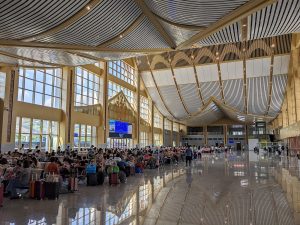Yesterday saw the beginning of crossborder passenger services on the China-Laos railway, a move that presages the tighter integration of the two countries.
The 1,000-kilometer rail line, which links the Lao capital Vientiane to Kunming, the capital of China’s Yunnan province, was completed in December 2021, but crossborder services have since been limited to freight transports due to the barriers erected by Beijing’s severe “zero COVID” policies.
The Chinese state news agency Xinhua reported that the first train departed from Kunming South railway station for Vientiane yesterday, at the auspicious time of 8:08 a.m. According to a report in the International Rail Journal, the will be one train running in each direction per day, and the total time of the journey will take 10-and-half-hours, including two short stops for customs checks. First class tickets for the full journey are available for 760 yuan ($110) while second-class tickets are priced at 470 yuan ($68).
The Laos-China Railway, which broke began construction in 2015 and marks the first extension of China’s high-speed rail system into Southeast Asia, is as a flagship of the Belt and Road Initiative (BRI) in Southeast Asia.
As such, the development was widely covered in the Chinese state media, couched in wooly rhetoric of amity and mutual benefit. The passenger services, Xinhua declared, “meet the aspirations of the people of the two countries for cross-border travel and continue to foster a path of development and friendship.” More concretely, Xinhua stated, the railway has since its opening has handled 13.93 million domestic passenger trips and transported 18.38 million tons of cargo between the two nations.
Propaganda aside, the sections of the line that run through the hills of northern Laos are an undeniably impressive feat of engineering. The 417-kilometer stretch includes 61 kilometers of bridges and 198 kilometers of tunnels, which went a long way toward explaining its controversial $6 billion price-tag, which has contributed its share to Laos’ current heavy debt burden.
The opening of passenger operations between Vientiane and Kunming has capped off a quarter century that has seen a remarkable demolition of distance in the borderlands between China and mainland Southeast Asia. For most of history, the rolling, emerald-green hills of southern Yunnan and northern Laos, Vietnam, and Myanmar formed an almost impenetrable barrier to outsiders, closed to all but the most hardy settlers and traders, while the peoples that dwelt in these regions enjoyed virtual independence from the major lowland states.
Since the end of the Cold War, and in a more intensive way since the first decade of the 2000s, transport infrastructure (mostly highways) has threaded its way through this terrain, prompting a reorientation of the region’s economy to the north. Laos, in particular, has seen significant flows of Chinese capital that have reshaped the urban landscape of Vientiane and other Lao towns, which now boast large communities of Chinese expatriates.
Given the two nations’ vast asymmetries of size, the opening of passenger services between Vientiane and Kunming is likely to have a much more profound impact on Laos than on China. It will likely lead to a sharp growth Chinese tourism to northern Laos, particularly to the former royal capital of Luang Prabang, and to gradual a resumption of the Chinese expatriate presence that was partly interrupted by the COVID-19 pandemic. All told, with the demolition of a formidable barrier that once kept Chinese economic and political influence at bay, Laos’ economy is increasingly bound to that of its large norther neighbor.

































